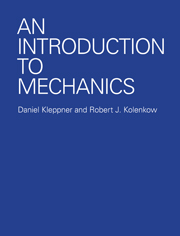Book contents
- Frontmatter
- Contents
- LIST OF EXAMPLES
- PREFACE
- TO THE TEACHER
- AN INTRODUCTION TO MECHANICS
- 1 VECTORS AND VECTORS KINEMATICS—A FEW MATHEMATICAL PRELIMINARIES
- 2 NEWTON'S LAWS—THE FOUNDATIONS OF NEWTONIAN MECHANICS
- 3 MOMENTUM
- 4 WORK AND ENERGY
- 5 SOME MATHEMATICAL ASPECTS OF FORCE AND ENERGY
- 6 ANGULAR MOMENTUM AND FIXED AXIS ROTATION
- 7 RIGID BODY MOTION AND THE CONSERVATION OF ANGULAR MOMENTUM
- 8 NONINERTIAL SYSTEMS AND FICTITIOUS FORCES
- 9 CENTRAL FORCE MOTION
- 10 THE HARMONIC OSCILLATOR
- 11 THE SPECIAL THEORY OF RELATIVITY
- 12 RELATIVISTIC KINEMATICS
- 13 RELATIVISTIC MOMENTUM AND ENERGY
- 14 FOUR VECTORS AND RELATIVISTIC INVARIANCE
- INDEX
7 - RIGID BODY MOTION AND THE CONSERVATION OF ANGULAR MOMENTUM
- Frontmatter
- Contents
- LIST OF EXAMPLES
- PREFACE
- TO THE TEACHER
- AN INTRODUCTION TO MECHANICS
- 1 VECTORS AND VECTORS KINEMATICS—A FEW MATHEMATICAL PRELIMINARIES
- 2 NEWTON'S LAWS—THE FOUNDATIONS OF NEWTONIAN MECHANICS
- 3 MOMENTUM
- 4 WORK AND ENERGY
- 5 SOME MATHEMATICAL ASPECTS OF FORCE AND ENERGY
- 6 ANGULAR MOMENTUM AND FIXED AXIS ROTATION
- 7 RIGID BODY MOTION AND THE CONSERVATION OF ANGULAR MOMENTUM
- 8 NONINERTIAL SYSTEMS AND FICTITIOUS FORCES
- 9 CENTRAL FORCE MOTION
- 10 THE HARMONIC OSCILLATOR
- 11 THE SPECIAL THEORY OF RELATIVITY
- 12 RELATIVISTIC KINEMATICS
- 13 RELATIVISTIC MOMENTUM AND ENERGY
- 14 FOUR VECTORS AND RELATIVISTIC INVARIANCE
- INDEX
Summary
Introduction
In the last chapter we analyzed the motion of rigid bodies undergoing fixed axis rotation. In this chapter we shall attack the more general problem of analyzing the motion of rigid bodies which can rotate about any axis. Rather than emphasize the formal mathematical details, we will try to gain insight into the basic principles. We will discuss the important features of the motion of gyroscopes and other devices which have large spin angular momentum, and we will also look at a variety of other systems. Our analysis is based on a very simple idea—that angular momentum is a vector. Although this is obvious from the definition, somehow its significance is often lost when one first encounters rigid body motion. Understanding the vector nature of angular momentum leads to a very simple and natural explanation for such a mysterious effect as the precession of a gyroscope.
A second topic which we shall treat in this chapter is the conservation of angular momentum. We touched on this in the last chapter but postponed any incisive discussion. Here the problem is physical subtlety rather than mathematical complexity.
The Vector Nature of Angular Velocity and Angular Momentum
In order to describe the rotational motion of a body we would like to introduce suitable coordinates. Recall that in the case of translational motion, our procedure was to choose some convenient coordinate system and to denote the position of the body by a vector r.
- Type
- Chapter
- Information
- An Introduction to Mechanics , pp. 287 - 338Publisher: Cambridge University PressPrint publication year: 2010



